These are comics/graphic novels we’ve read. We strive to find books with diverse characters and girl protagonists, so this selection reflects that. The books generally go up in order of reading level/maturity.
Most of these are rated on a goodreads shelf.
Note that the difference between comics and picture books can blur at the edges.
Publishers You Can Trust
- First Second - Science Comics, Ben Hatke books, and more of our favorites
- Toon Books - Different reading levels, diverse range of stories, non-fiction
The Books We’ve Read
Owly series, Andy Runton
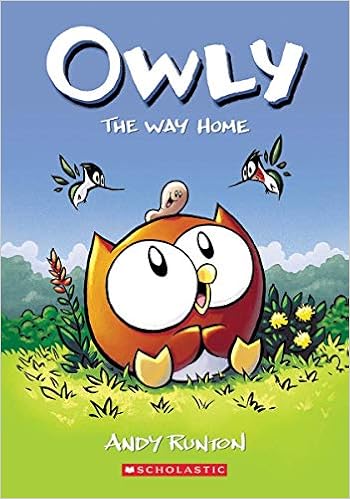
Mostly wordless comic books featuring the gentle adventures of an owl and its worm friend. While Owly and Wormy talk occasionally, they do so with pictograms. Note that since nothing says Owly is a boy, you can read it with the protagonists being girls. Artwork is straightforward but evocative.
Korgi series, Christian Slade

A series by someone who clearly enjoys drawing detailed fairies and corgis in pencil. Adventures of a Caucasian pixie girl (a “molly”) who has a magical corgi. Which is about as adorable as you can imagine. The wordless (minus the intros) stories can be quite scary, so you might have to edit for younger audiences.
Sketch Monsters series, Joshua Williamson
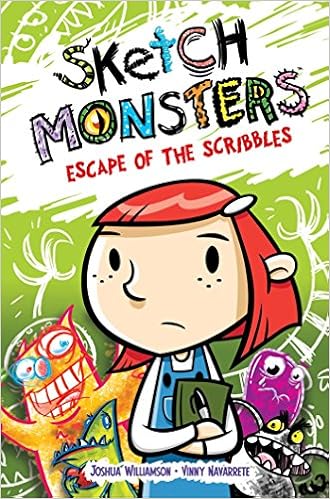
In this simple series, kids who doodle monsters to hide their true selves have to deal with the consequences when those doodles escape the sketchbooks. Simple messages about being true to oneself are carried by simple artwork.
Peter & Ernesto series, Graham Annable

Because who doesn’t love sloths? And maybe the notion that sloths are lazy is incorrect. Maybe they’re just content. Thus the tone is set for Ernesto, who wants to see and do new things, and his friend Peter, who is, well, content. The personalities of the two sloths, and the choice of language and sentence structure reminds me quite a bit of the Elephant & Piggie books. The stories are appropriately silly.
Kevin McCloskey comics (We Dig Worms, The Real Poop on Pigeons, etc.)
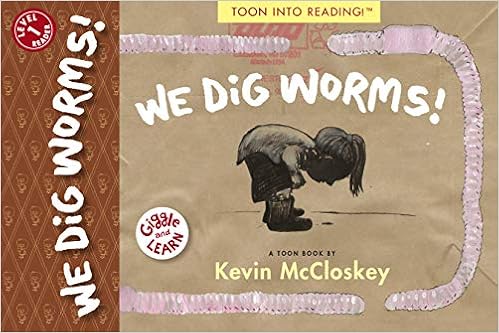
These books, published by Toon Books, are science-based comics for the younger reader. They pack a lot of information into a relatively small amount of fun text. Kids love facts, and these are good reads for them
Chi’s Sweet Home series, Kanata Konami

If you have cats, you’ll particularly appreciate this manga about a kitten who moves in with a Japanese family (despite a no-pets rule in their apartment) and has adventures around the neighborhood with other cats and dogs. Konami perfectly captures the mindset of a cat and the humans who see it. Warning, if you read it aloud to your kids, you’ll be reading a lot of sound effects.
CatStronauts series, Drew Brockington
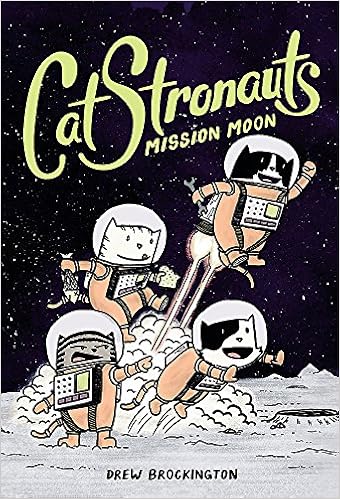
I mean, it’s called CatStronauts and the primary characters are Waffles, Pom-Pom, Blanket, and Major Meowster. So you kind of know what you’re signing up for, don’t you? The adventures remind me of the Rocky and Bullwinkle genre, wherein something tremendous is at stake and the heroes are the ones to execute a somewhat bonkers plan to solve the problem. That said, Brockington loves space and adds a veneer of truthfulness to the stories: In the first one, for example, the cats need to build a space-based solar power station to transmit energy to the earth on microwaves – a real concept – and when the rocket launches, there’s an extended sequence in which all the cats in Mission Control give their go/no go signals. But, in the end, it’s cats being silly space travelers.
Dog Man series, Dav Pilkey

The conceit here is that two kids are revisiting the Dog Man (and Captain Underpants, which is also from the same real-world author) comic books they wrote as first-graders, and that’s pretty much how the books read. Expect potty humor, simple jokes, and outlandish behavior. These are books that kids can talk about with each other and that adults will roll their eyes about.
Cat Kid Comic Club, Dav Pilkey

While Dav Pilkey’s books are not for me (and this is the point; they’re clearly set up for kids to read them and revel in the fact that their parents find them gross), I’ve always been impressed by the detailed character-drawing instructions in the back of the Dog Man books. I know of a number of kids – including my own – who have dutifully followed every step to draw their own Dog Man or whatever. In this series, Pilkey goes even farther, turning Dog Man character Cat Kid into a teacher helping a school of frogs write their own comics. The emphasis is definitely on being creative and not listening to naysayers (such as parents who don’t want gross humor), while offering simple lessons that will help inspire kids to create their own works. Lots of “kid-authored” comics appear in the pages.
Yotsuba&!, Kiyohiko Azuma
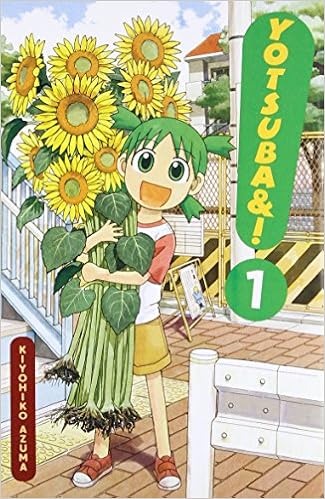
This popular manga features the adventures of an energetic and curious five-year-old after she and her adoptive father move to a new house. She quickly befriends the neighbor girls and has a variety of cuckoo (but age-appropriate) adventures with plenty of slapstick and misunderstandings. American parents might be surprised by the independence she’s given, and will definitely notice adult topics such as her dad’s friend accusing the dad of sleeping with one of the underage neighbor girls (he was’t), but our daughter enjoyed the silly antics of a younger child.
Hilda series, Luke Pearson

One of our favorite series. The adventures of a Caucasian blue-haired girl who lives in a vaguely Nordic area and has lots of adventures with the fantastic creatures she meets there. Hilda is a great character, not just because she’s a clever, adventuring girl, but also because she feels real. She rolls her eyes at her mum’s attention, has realistic reactions to friends, and so on. But she’s a fundamentally good kid. Midnight Giant is my favorite of the series for its parallel structure, but our daughter’s favorite is The Black Hound. There’s a Netflix series about her as well, though it departs fairly strongly from the books.
Drew and Jot, Art Baltazar
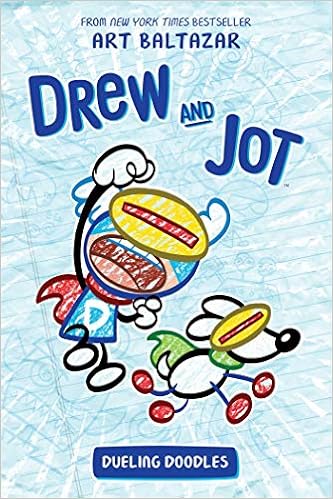
Drawings escaping from a child’s notebook and into the real world is a popular idea with authors who write for children: Just in this list there’s Sketch Monsters (above) and Doodleville (below). This brightly colored, boldly drawn book sees two boys who both love to draw swapping ideas for their two favorite characters, whose adventures play out as pages in this book with occasional peeks back into our world. And then Andrew’s young sister gets in on the fun, and things go really bonkers. A cuckoo plot with lots of action makes this a quick, enjoyable read.
Cucumber Quest series, Gigi D.G.

This zany and far-reaching fantasy series features an ensemble cast, dubious motivations, and witty dialog. Parents will see a lot of extra jokes, but kids will enjoy it, too. The book starts with a “chosen one” rabbit creature who doesn’t really want to be chosen, while his sister is all about the fighting. At one point, she deliberately helps the villains in the piece so that she’ll have something to fight. The two collect extra friends as they wander the kingdom to power the sword that will defeat the gigantic Nightmare Knight. At least for a bit. This also exists as a webcomic if you want to read it that way.
Nico Bravo series, Mike Cavallaro
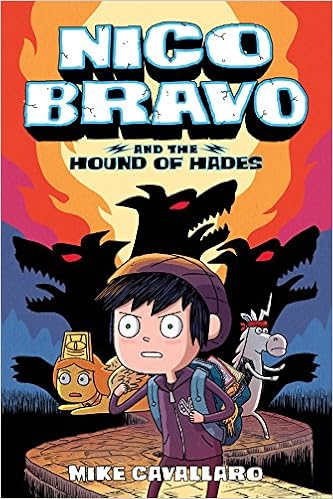
Nico Bravo is a clerk at Vulcan’s Celestial Supply Shop when Eowulf, the great-great-etc. granddaughter of Beowulf, comes in to the shop. She’s determined to slay Cerberus, and Nico ends up going with her in an attempt to dissuade her. Not all monsters are bad, he tells her. The two end up romping around various mythological universes in their parallel quests. Meanwhile, the unicorn who’s also a clerk finds himself on a time-traveling adventure to the future where Nico has not been successful stopping Eowulf. Lots of zaniness and silliness, but the epilogue sets up for a deeper plot.
Mellybean series, Mike White

When Melly the dog is encouraged by his three cat hosemates to go play outside so they can lock him out, he starts digging and finds himself in an alternate world which starts with him meeting a giant monster who is, it turns out, not really a monster. This funny series will have your kids laughing at the hijinks and silliness as Melly returns to the kingdom to defeat a greedy king and a wicked wizard.
Once Upon a Space-Time, Jeffrey Brown

This graphic novel reads more like a narrative arc told through comic strips, and is a good step up for those who liked Catstronauts (see above) but maybe aren’t quite ready for Sanity and Tallulah (see below). When humanity makes first contact with a prank-loving alien named Tobey (who is in fact merely one of the many Tobey clones, all called Tobey), elite astronauts are excited to venture into space with the high-tech systems Tobey has shared with us. Instead, two human children are chosen – it’s not really clear why – and venture off to Mars, where they meet other aliens and stumble through a series of mild adventures. Lots of kid-friendly humor mixes with reasonable science and facts to create a somewhat absurd story that is sure to keep kids laughing.
Princess Princess Ever After, Katie O’Neill
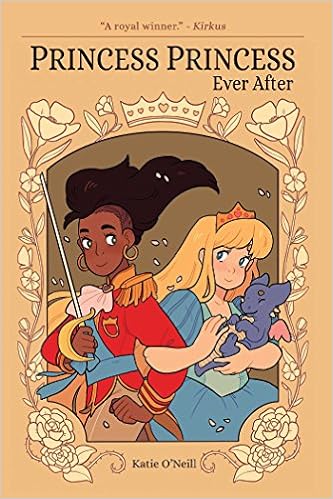
A decidedly feminist take on the standard fairy tale, this quick read features a woman of color rescuing a Caucasian princess in a tower. Said princess has been locked there by her older sister, who doesn’t want competition for the throne and who denigrates her younger sibling by calling her fat and stupid. There’s a fair amount of “not nice” language, like the aforementioned “fat” and “stupid” and a prince the women nickname Butthead. The two princesses end up by getting married.
Sea Sirens: A Trot and Cap’n Bill Adventure, Amy Chu & Janet Lee

This richly drawn comic (whose style evokes Fish Girl below) features Trot, a Vietnamese-American surfer, and her cat Cap’n Bill as the two discover the underwater queendom of the sea sirens and their mortal enemies the Serpents. The tale draws inspiration from a number of sources, including Vietnamese folklore, and follows a number of tropes along the way. Still, there’s a surprise twist in store for the reader. Note that her grandfather suffers from dementia, and the plot is often driven by his confused lapses.
The Cardboard Kingdom, Chad Sell (and others)

There’s a lot going on in these pages, which is largely about a group of kids having intense imaginary play, fueled by discarded cardboard. The artwork goes back and forth between how an adult might see the kids – boxes on heads and chunky cardboard accessories – and how they see themselves – heavily stylized with flowing robes and glowing armor. There are kids with family issues, kids of color and different sexual orientation, kids with big imaginations, and kids with more analytic streaks. The stories in the book tie together, but largely focus on particular characters for their arc.
Doodleville, Chad Shell
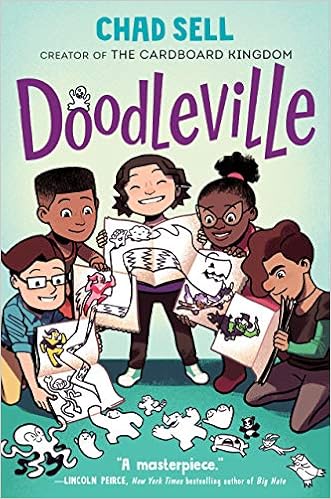
In Drew’s world, the term “dynamic art” takes on a whole new meaning. Drawings and paintings aren’t confined to the page they’re on. But Drew’s Doodles don’t behave themselves the way other kids’ characters do, and this puts Drew at odds with her classmates as she tries to wrangle her boisterous art. When a museum trip inspires her to draw a leviathan, she accidentally infuses it with her own self-doubt and anxiety, and it becomes a fearsome monster that wreaks havoc on her friends’ sketchbooks. Between this and The Cardboard Kingdom (see above), I’d happily just buy anything Chad Sell produces. This world is imaginative and allows him to tell a story about feelings and friends that is reminiscent of Sketch Monsters (also see above) but for a somewhat older crowd.
Hilo series, Judd Winick

A burping robot boy who can fly and shoot lasers from his hands is the titular boy, which will no doubt appeal to many children. But beyond the lowbrow humor, there’s a lot of depth in these books; even in the first book, it’s hinted that Hilo is both the solution and the cause of the problems facing Earth, and that the “bad guy” maybe has the right message but the wrong implementation. One could maybe raise an eyebrow about a basically Aryan kid come to save the sidekicks who are people of color, but the girl in that set is also a super nerd.
Star Scouts, Mike Lawrence

Avanti is having a hard time fitting in to her new school in this first book of a fun trilogy. Her father has her join the local Flower Scouts to meet new friends, but she finds the members boring (though sharp readers will notice one who stands out long before it becomes obvious at the end). Then she’s abducted by another Scout: an alien who was trying to collect a newt for a Star Scout badge. She missed her target … which … turns out to be not atypical with her efforts. Avanti then finds herself in a science fiction universe, and teleports back and forth to that each day when her dad thinks she’s at Flower Scouts. She ultimately gets a chance to go to sleepaway camp with her alien troop, and enters a competition with a rival troop that will determine if humans should be allowed in to Star Scouts at all. There’s kid-friendly gross-out humor, jetpack races, middle-grade friend drama, and a host of escapades.
Phoebe and Her Unicorn series, Dana Simpson

This series is pretty witty, but note that a lot of the humor relies on sarcasm and the common experiences of grade school kids. The series features a Caucasian girl who befriends an astonishingly vain unicorn. It’s often compared to Calvin and Hobbes (sadly, as in “Calvin and Hobbes for girls” as if girls can’t appreciate Calvin and Hobbes or boys can’t appreciate Phoebe and Her Unicorn), probably because the unicorn often has wry observations of humanity and Phoebe is a bit of an outsider at school. This is a series my daughter returns to again and again.
Babymouse series, Jennifer & Matthew Holm

Lots of kids love this series about a mouse going through school and having typical schoolkid adventures (jealous of friends, wants to be popular, etc.). We found it fairly dreary and stopped reading after a couple books.
Pets on the Loose! series, Victoria Jamieson

What happens when well-known rodent criminals get turned into school pets? Well, they go a bit soft. Their priorities change. And suddenly they’re battling their equivalents from the older kids’ classrooms. Goofy plots and elaborate capers make for an enjoyable, light read
The Tea Dragon Society, Katie O’Neill
 A gentle fantasy story about Greta, who discovers the almost-lost art of raising tea dragons, small animals who grow tea leaves that impart visions when steeped. A loving gay relationship and multiracial characters make for a diverse cast, but the joy is really in the appreciation of artisanal products.
A gentle fantasy story about Greta, who discovers the almost-lost art of raising tea dragons, small animals who grow tea leaves that impart visions when steeped. A loving gay relationship and multiracial characters make for a diverse cast, but the joy is really in the appreciation of artisanal products.
Aquicorn Cove, Katie O’Neill

This sweet and simple story features young Lana visiting her Aunt Mae at the seaside town where Lana and her family lived before her mom – Mae’s sister – died at sea. While there, she takes care of a small not-quite-seahorse (the titular aquicorn) and learns that her aunt once met an undersea resident but ignored her pleas to take better care of the ocean, saying there wasn’t anything the small village could do in the face of such destruction. By the end, the land dwellers have come around to taking care of the ocean better, even in small ways. Aunt Mae is a a muscular, dark-skinned woman (Lana is drawn as lighter-skinned, as is her mother), and some readers might read her friendship with the underwater woman as romantic, but that’s only hinted at in the text.
Misadventures of Salem Hyde series, Frank Cammuso
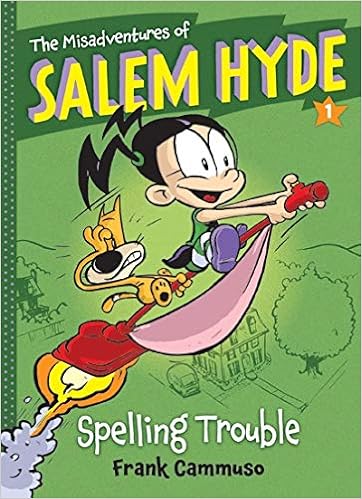
Salem Hyde is a witch living in a non-magic world. Frank Cammuso’s sight gags and wordplay are on fine display here as Salem has a variety of misadventures of the magical kind. Fun and giggle-inducing.
Magic Trixie series, Jill Thompson

This story would be about normal childhood emotions – jealousy about siblings, being dissatisfied with one’s own life, wanting to do things you’re not allowed to do – except the Caucasian protagonist and her family are all witches of various forms. And her friends include vampires, werewolves, and mummies. Rich graphics provide lots of detail to enjoy, and there are in-jokes for the parents as well.
Edison Beaker series, Frank Cammuso

Edison Beaker, who loses his dad at the beginning of the first book, is afraid of the dark. But he wards it off with the flashlight his dad gave him before disappearing. When he and his sister Tesla are left with their uncle for a time, they discover that the family business of “pest extermination” is really more of a Ghostbusters enterprise, and he and his sister get swept up into a quest to deal with the denizens of The Underwhere (much snickering here). The action is fast-paced, and some of the scenes might be scary for younger readers, but overall this is a light adventure with goofy evil henchmen, an escape artist hamster, and some sort of warrior elf girl who teams up with Edison. All the human characters are Caucasian.
Bera the One Headed Troll, Eric Orchard
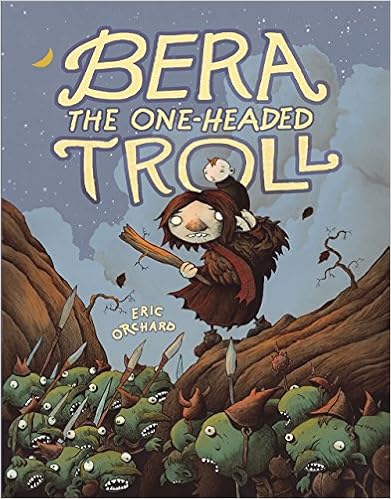
Bera, a pumpkin farmer in the land of trolls, rescues a human baby from evil mermaids and sets off to return it to a human village. She tries to find help from troll heroes and other assorted magical creatures while staying a step ahead of a witch who wants to cook the baby, but ultimately has to solve the problems herself. The artwork in this fairy tale, done in browns and oranges, evokes The Nightmare Before Christmas, but is its own unique style.
Pilu of the Woods, Mai Nguyen
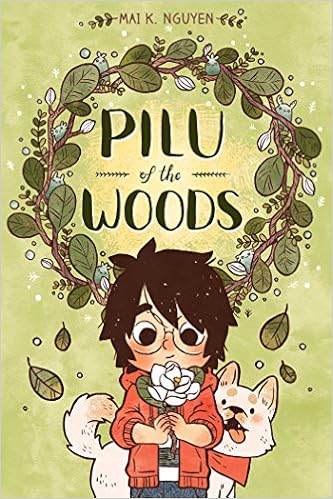
Willow is feeling pretty depressed about her mother’s recent death, and the school bullies aren’t helping. She retreats to the nearby woods, a place she visits often with her dad. She meets Pilu, a wood spirit, who has run away from her mother and sisters. Willow helps her find her way back, but on the way the girls have to deal with Willow’s emotions as they come to life. The feelings are represented as green monsters trapped in bottles. Each girl teaches the other a lesson that helps her appreciate her own life. A more somber take on feelings-as-monsters than Sketch Monsters.
Twins, Varian Johnson
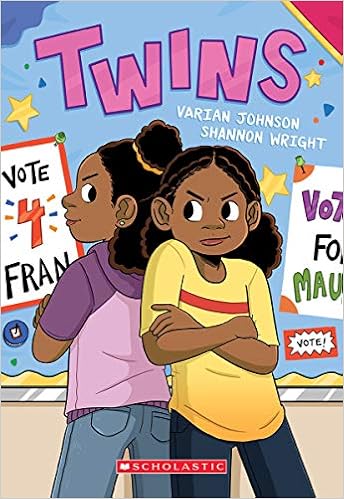
Francine and Maureen are identical twins who have always hung out together and with their friends. But at the start of a new school year, Socially savvy Francine wants to carve out an identity separate from quiet and smart Maureen, while Maureen just wants things to continue on as they always have. Francine signs up for separate classes and asks her parents to put Maureen into other programs. The sororal tensions escalate when Maureen decides to run for class president against Francine. The tension is thick in this book and, while told from Maureen’s point of view, gives the reader a sympathetic view of each of them.
Diana: Princess of the Amazons, Shannon Hale & Dean Hale

Yes, that Diana. This is a cute, lower-middle grade entrypoint for Wonder Woman, written by the Hales – most known in our household for The Princess in Black. In this story, Diana bemoans being the only child on an island full of adults who are immortal and the best at everything they do. Especially when her mom has less and less time for her. So, remembering her own origin story, she seemingly creates a friend for herself out of clay and sand. The friend isn’t what she seems, but before we find that out, we see her tempting Diana into mischief and troublemaking against her Paradise Island neighbors. There are some nods to the larger Wonder Woman universe, but you needn’t know anything about that character to enjoy this story.
Zatanna and the House of Secrets, Matthew Cody
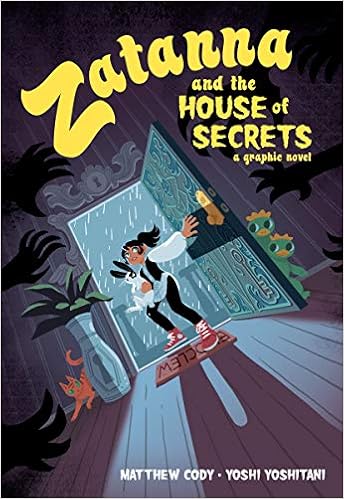
Much like Diana: Princess of the Amazons, Zatanna and the House of Secrets tells a story of the teenage years of a DC superheroine, though this one somewhat less well known than Wonder Woman. I don’t know much about Zatanna the character, but this is a fun story in which she learns that not only is her dad not simply a stage magician, but that she too is a real magician who can make things happen by saying words backwards. And her house is named The House of Secrets, full of mysterious magic. And the family’s pet rabbit can talk. Big day! In this adventure, she has to stop The Witch Queen from taking over the House and rescue her dad. As with Diana, I’m sure there are allusions to Zatanna’s more adult storylines, but you certainly don’t need to know them to enjoy the story.
Lois Lane and the Friendship Challenge, Grace Ellis
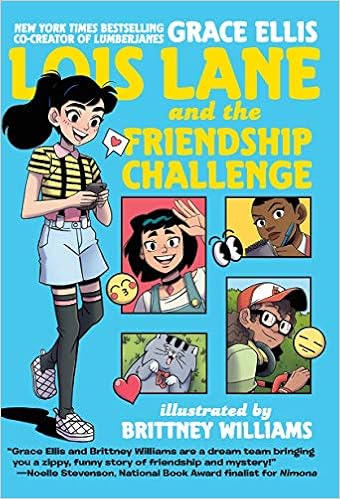
Think of this less as a Lois Lane story and more as a modern-day typical middle-grade story with some Lois Lane accessories. In this book, a tweenaged Lois Lane is planning a frenetic summer with her best friend, who is going away to stay-away camp for the first time. Standard middle-grade fare of jealousy of new friends, anxiety about keeping your friends, and an initial desire for external validation are the real story here, though the upfront plot is about a mysterious fireworks theft that threatens a local business. Lane is dismissive of journalists until the end, so I guess this could serve as an origin story for her, but aside from some winks here and there, there’s nothing to suggest her future role in DC Comics.
Bone series, Jeff Smith

Ask a dozen current, middle-ageish comics artists for inspirations, and Bone is likely to come up a few times. But I personally found it kind of meh. My daughter loved the antics of the blob-headed Bones, from everyman Fone Bone to conniving Phoney Bone to dim-witted Smiley Bone, but I found it tough to care about any of the characters or their plights, and all the characters seemed like exaggerated types. That said, the story takes a number of twists and turns and is fairly epic in nature, so it has a lot going for it. Note that many of the characters smoke.
Amulet series, Kazu Kibuishi

Google “graphic novels for kids” and this series is certain to show up early and often. We know at least one family who credits this popular series with getting their kid to read, and it’s not hard to see why. It’s an intense epic fantasy that takes place in a surreal, vividly imagined world. The Caucasian female protagonist finds a magic stone her great-grandfather left in his house, and she enters the realm where he disappeared to. His homemade robots become both servants and allies as she battles against the malicious elves and sinister forces at work among the other Stonekeepers. I particularly like that the stone isn’t just default good. It shapes itself to its wielder’s desires and heart, even as it tries to tempt the wielder to take – or perhaps relinquish – control.
The Aquanaut, Dan Santat

Much like Amulet, above, this book starts with a father dying as his research ship sinks. His brother and other crewmates make it out with “their greatest work.” We pick up the story a few years later, as a mysterious figure in an old diving suit emerges from the ocean. The diving suit is being driven like a vehicle by a few undersea creatures, who consider themselves to be entering space. They quickly meet Caucasian girl Sophia and recognize her as the daughter of the man whose boat they left after it sank. Hilariousness ensues as Sophia tries to help the Aquanaut pretend to be a human. There are some underlying themes about capitalism’s aims versus science and conservation as well as empathizing with creatures unlike ourselves.
A Man and His Cat series, Umi Sakurai

While this manga is probably enjoyable by younger readers, there are many hints of sadness: from the cat sitting forlornly in the pet shop waiting for a home to the man who finally buys him pining for his deceased wife. But the rest of the series is an aw-inducing story about a lonely man adopting an unwanted cat and how the two bond. Cat lovers will recognize all sorts of hilarious cat behaviors.
Pashmina, Nidhi Chanani

Indian-American protagonist Priyana has lots of questions about India, her father, and her mother’s life before her. Questions her mom simply doesn’t want to answer. But Priyana finds a magic-infused pashmina that gives her a glimpse of that other world and furthers her desire to go to India. The pending birth of a niece gives her an excuse, and together she and her aunt track down the history of the pashmina. In some ways, this book feels like a disjointed narrative that exists to tell the story of a factory fire that killed a number of women in India. Older readers and certainly adults will see a lot of sexism in the male attitudes towards women.
Cici’s Journal series, Joris Chamblain & Aurélie Neyret

This beautifully drawn series has rich, deep storylines set in the real world. Cici is a would-be writer who finds interesting mysteries around her and works with her friends to get to the root of them. Cici is Caucasian, as are most of the people around her (the books are imported from France or Belgium)
Island Book, Evan Dahm
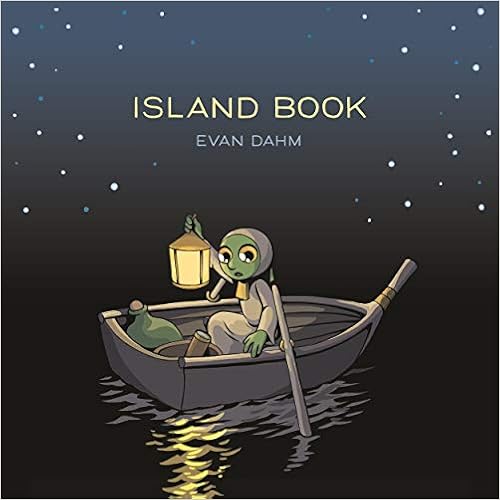
This story features a young alien woman who sets out to learn about a monster that seems drawn to her. She sets out from her island on to a sea that her people have always said is empty of all but the monster, but quickly discovers that there are a number of islands out there, each with their own unique species and stories. The story leaves some ends dangling, but there’s a #1 on the spine, so presumably later stories will explore the world more.
Zita the Space Girl series, Ben Hatke

Look up “comics books for girls” and Zita is likely to be near the top of the list. We’re big Ben Hatke fans, largely because of this sci-fi adventure. Zita and a friend (a boy, both Caucasian) get sucked into a spacefaring civilization and have to make their way back home. Colorful characters in an ensemble cast support the friends as they navigate the new worlds. We read it to our daughter when she was quite young, but she recently re-read it herself by doing one book a night.
Mighty Jack series, Ben Hatke

There are some intersection points with the Zita series (read that series first to get the jokes) but this is a standalone fantasy series that focuses on a Caucasian boy, his autistic sister, and a fierce Caucasian friend (girl) who lives down the street. The three plant a garden with out-of-this-world (literally) seeds that create a range of adventures.
Donut the Destroyer, Sarah Graley
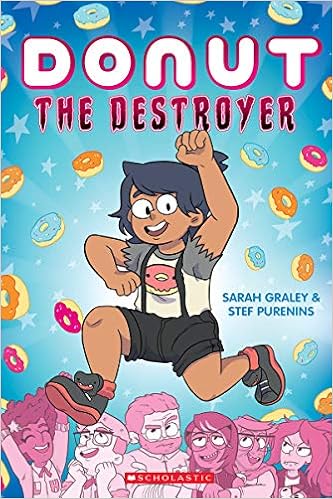
First name, Donut. Middle name, The. Last name, Destroyer. Donut is the child of famed supervillains The Destoyers, but she really just wants to be a hero. Her friend wants her to stay a villian and tries to sabotage her chances at hero school so she’ll get turned out and will have to go villain school, where her friend imagines Donut being the perfect sidekick. A witty version of the reality that friendships change and personalities become more independent in middle school.
Pawcasso, Remy Lai

When Jo sees a dog trotting to stores with a basket in hand, she follows it and doesn’t get a chance to deny it when people assume she’s the owner. But she enjoys being so popular thanks to the dog, and continues to lie about the dog being hers. The lies escalate – soon a broad swath of the town is fighting a political battle on behalf of her and “her” dog – until the inevitable discovery of the truth. Jo then has to make amends in a quick post-climax wrap-up. Older readers may see some of the twists coming, and I feel like Jo would be having more physical manifestations of her anxiety: stomachaches, nausea, etc. But this is a very enjoyable, fun read that will appeal to dog lovers of all kinds.
Chasma Knights, Boya Sun & Kate Reed Petty

This book (maybe first in a series) drops you right into a vividly colored surreal world in which “knights” named for chemical elements bond with “toys” to make incredible devices and experiences. Except for the main character, who, as a neon knight, can’t fuse with toys. Instead, she figures out how to make new and more interesting toys by scavenging parts from others. Looks like standard kid themes of isolation, finding a small number of good friends over being popular, and wanting to show up those who teased you. There’s also an undercurrent of how destructive capitalism can be.
The City on the Other Side, Mairghread Scott

What if the 1906 San Francisco earthquake were actually caused by a massive war in the land of fairies, which occupies our same geography but on the other side of a mystical veil? This is the situation Latina protagonist Isabel finds herself in when she accidentally crosses the veil and sets out on a quest to rescue the Seelie Fairy Queen from a mystical prison. She’s chased and aided by a host of fairies as well as a Filipino boy who survived the quake. There are lovely visual details in the rich spreads, and the back matter talks about SF’s history and the artistic inspirations for the characters.
Rapunzel’s Revenge, Shannon & Dean Hale
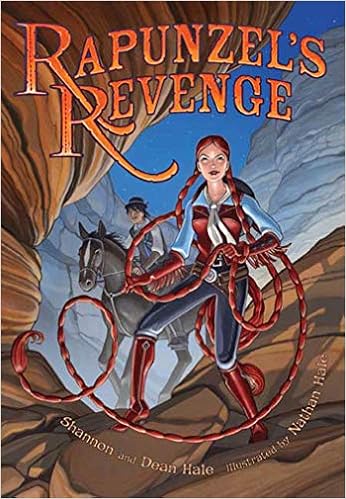
Trust Shannon Hale (Princess in Black, among others) and, uh, sure, her husband Dean, to make a version of Rapunzel in which the fairy-tale warhorse is given more agency and strength. In this version, Rapunzel lives in a Wild West-type world, with Mother Gothel at first keeping her in her villa with an impossibly tall wall before imprisoning her inside a tree in a swamp when she becomes a rebellious teenager. Though in this case the rebellion is all about rescuing her mom, imprisoned in Gothel’s mines. When Rapunzel breaks herself out of her tower, she meets up with Jack of the beanstalk, and the quest to save Rapunzel’s mom becomes a larger quest to destroy Gothel and free the land from her tyranny. Rapunzel’s hair becomes whip, lasso, and more as she defeats the many outlaws in the barren land.
The Okay Witch, Emma Steinkellner

Moth Hush is living a normal life as a put-upon middle-schooler in Founder’s Bluff, MA, when she discovers that she’s actually a witch. And her mom is a witch, too, who was in fact born in the late 1600s. But the witches around Founder’s Bluff were chased out for spurious reasons by the ancestors of the still-prominent Kramer family, and the witches retreated to a mystical realm outside of time and space. Moth uses her mom’s journal to see the past of the town and her family, despite her mom’s reluctance to talk about, and especially teach, witchcraft. It’s not hard to see Moth’s blossoming magic as a stand-in for puberty, and it’s easy to see how the Kramers have really been more about oppressing women and women of color than protecting their town. It’s also easy to see a “who writes the history books” theme as Moth learns the reality of historic events. Still, the author ends on a hopeful note as the town’s mayor promises to be better and Moth’s mother and grandmother begin to reconcile their painful estrangement.
The Leak, Kate Reed Petty
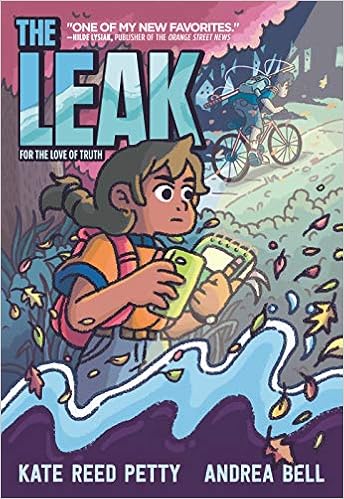
Aspriring journalist Ruth Keller, a middle-grade girl from what seems to be a mixed-race household, is excited to share news stories with the few dozen people who get her email newsletter. But when she meets a real-life journalist from the New York Times, she gets pointers on how to properly report the mysterious water pollution she’s uncovered. She soon has hundreds of subscribers as she exposes companies serially violating water regulations. She makes some initial missteps, and the polluting company clearly wants to flatter her into delivering a polished message that’s friendly to them, but Ruth pushes forward to deliver a true news blockbuster to her community. Very obviously inspired by the horrible water situation in Flint, Michigan, this paean to real journalism, fact-finding, and empowering your own community is a great read for would-be activists.
W.I.T.C.H. series, Elisabetta Gnone

You could be forgiven for thinking that this is an English-language translation of a typical Japanese magical girl manga (complete with silly superhero costumes and willowy bodies), but in fact it originated in Italy. The multivolume saga tells the story of five ordinary teenage girls gifted with wide-ranging magical powers so that they can act as Guardians of the Veil, who are supposed to protect a dimensional bridge between Earth and the kingdom of Metamoor. Or something like that. There is definitely some kissing and crushing, but nothing gets too serious.
Sanity and Tallulah, Molly Brooks
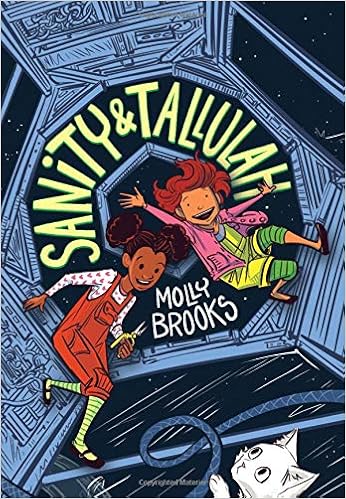
This large sci-fi volume focuses on two girls who live on a giant space station. Like any other tweenage girls, they go beyond the rules sometimes. In Sanity’s case, that means creating a three-headed kitten – Princess, Sparkle, Destroyer of Worlds – in the station’s bio labs. Subplots around Tallulah’s father hint at stories that don’t make it into the first volume, but the main story is about the space station going on the fritz due to some sort of invasive pest – who shows up right when Princess, Sparkle, Destroyer of Worlds goes missing. The artwork shows off the diverse residents of the station as well as the many interiors.
Fish Girl, Donna Jo Napoli & David Wiesner

A Caucasian mermaid lives in a water-filled house and gradually learns that she’s being held from her true home by the sideshow entertainer who plays the part of Neptune in his shows. She slowly figures out how to get free. This is a bittersweet story, and there are some parts that parents will read as leering boys harassing a pretty girl, but it’s filled with Wiesner’s rich artwork and touches on themes of friendship, loss, and home.
Clan Apis, Jay Hosler
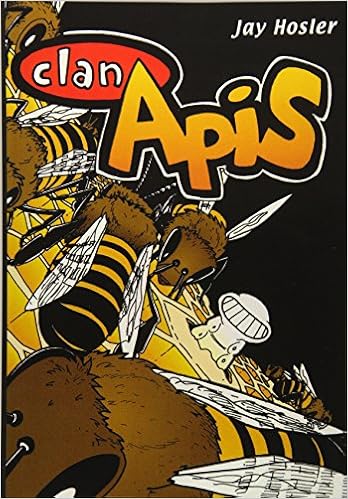
Think science comics won’t move you? This is a book that imparts a huge amount of information about the science of bees in a good narrative. The story focuses on a single drone’s life, but her eager questions about the world around her drive a lot of science in with the plot. The end is moving – bees don’t have a long life – and there is loss and victory throughout.
Secret Coders series, Gene Luen Yang
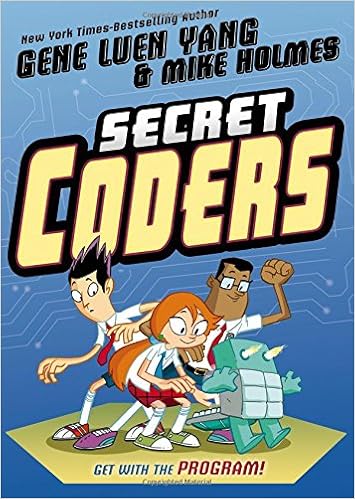
I don’t know what about this series clicked with my daughter, but she absorbed this series eagerly. Three kids, a Caucasian girl named Gracie Hopper, an African-American boy named Eni, and an Asian-American boy named Josh use Logo to save the world. No, really. Some well-known real-world references (Seymour Papert, Flatland), but otherwise a complicated science fiction plot. Many pages in each book are devoted to stepping through increasingly complex Logo problems.
Jellaby series, Kean Soo
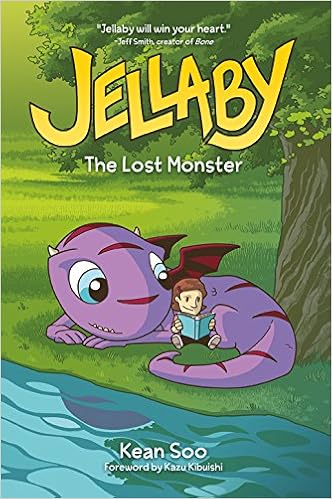
This two-book series, in which the two protagonists work to restore a purple monster to its home, has some very frightening aspects, but ultimately follows a heroic arc. A fair amount of the book takes place in the nightmares of the Caucasian girl at the center of the book.
Brave Chef Brianna, Sam Sykes & Selina Espiritu
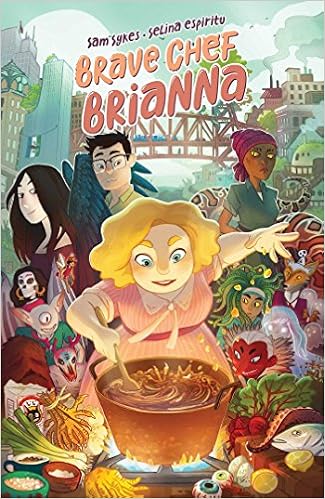
Brianna’s father is a world-famous chef, and he challenges his kids to set up their own shops and compete for the right to use his branding going forward. Brianna sets herself up as a restaurateur in a city mostly populated by “monsters.” There are clear notes about prejudice and tolerance and feeling good about one’s self and believing in something here. Brianna (Caucasian, like her siblings) is full of self-doubt, and uses lots of mean words to describe herself, but ultimately triumphs – if not in the way readers anticipate.
Sunny Side Up, Jennifer L. Holm

This is a pretty light book when you consider that drug addiction is a prominent theme. When we first meet Caucasian Sunny, she’s been sent to spend the summer of 1976 with her grandfather in a retirement community in Florida. She soon meets another kid, the groundskeeper’s child, and the two have standard summer idyll adventures: reading comics, collecting golf balls, scrabbling for money, and so on. But periodic flashbacks tell the reader how she ended up there – her parents are trying to help her drug-addicted brother, and they want her clear of what will certainly be a hard journey for him. The tension of keeping secrets finally causes her to explode, which in turn lets her grandfather give her some words of advice. An author’s note addresses readers frankly about dealing with an addicted family member.
Abigail and the Snowman, Roger Langridge
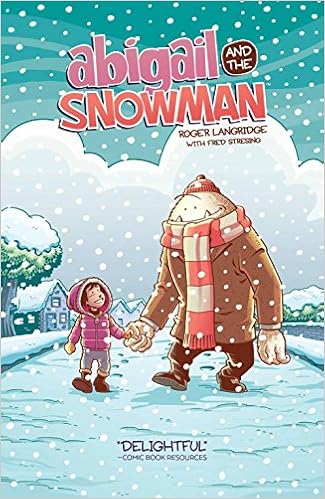
Abigail (possibly Caucasian, possibly of color – the shading makes it hard to tell) befriends a yeti who has escaped some sort of secret government lab. There’s violence here (helicopters being shot down) along with a frightening moment where it seems like the yeti has died, but it all works out on the end.
The Courageous Princess, Rod Espinosa

When Princess Mabelrose gets kidnapped by a dragon and taken far from home, she decides to effect her own escape rather than waiting for a prince or a ransom. With courage, kindness, and some fortuitous treasures from the dragon’s lair, she makes her way across the sprawling continent where she lives, helping those she meets even as her father moves southward to begin his own rescue. This sprawling, imaginative, lushly drawn, multiethnic fantasy (though Mabelrose is drawn as Caucasian) is full of allusions to other fairy tales and stories. A bit too much time is spent on noting that Mabelrose isn’t your standard princess-pretty (though she’s actually drawn as quite attractive), but no one denies her bravery and courage. The first book in particular also devotes a lot of time to her and her family praying, which is not common in the comics we typically read.
Four Points series, Hope Larson
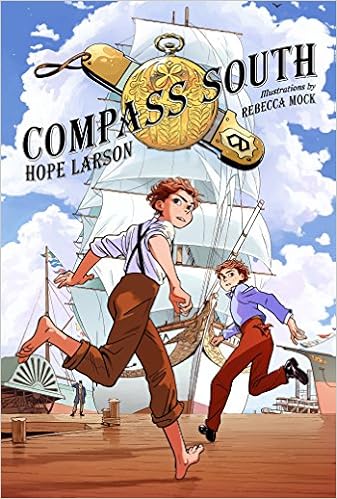
If Robert Louis Stevenson wrote graphic novels, there’s a good chance they’d look like this fast-paced adventure. Orphans, buried treasure, traps, twists, vengeance, and more keep this mid-19th-century tale going at a fast clip. Alex and Cleo, redheaded Caucasian twins who are (they think) newly orphaned, are on the run from a pirate gang whose captain is intent on retrieving the knife and watch they carry. The two items together reveal coordinates to the treasure stash hoarded by their real parents, who were themselves pirates. Cleo pushes back against the sexist norms of her day, though she doesn’t make us much traction as one would like.
The Nameless City series, Faith Erin Hicks
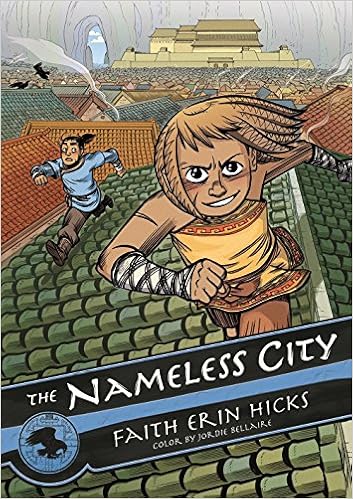
This rich, action-filled story of politics and war is set in a city that has been conquered so many times the long-term residents simply call it “The Nameless City.” Thirty years ago, the Dao “brought peace” to the city by conquering it yet again. Into this comes a teenager from the Dao empire, the son of a powerful Dao chief and a Dao general. He shortly meets and befriends a city girl who calls herself Rat, and the two work together to help convert the city into one ruled by a council of nations. Rat teaches Kai her parkour-esque running style, which the two use to bring about the change that promises to bring real peace to the city. Hicks based her artwork and ideas on 13th-Century China and does a powerful job of crafting a world where city residents are resigned to waves of oppression while also resenting them.
The Dam Keeper series, Robert Kondo

Young protagonist Pig (who is in fact a pig) is the dam keeper of Sunrise Valley, a job he inherited after his father disappeared into the dark mist that covers the world and that the dam holds at bay. After Pig (and his friends Fox and Hippo – one wonders what their parents are named) notices that the dark mist is retreating and pounding against the dam in a new pattern, his dam is damaged and he has to go into the world outside the town’s borders. Along the way, he encounters other outposts of light populated by muppet-like animals, kept safe by their own dams, and begins to understand why the dark is behaving the way it is. The lovely artwork in this could be tough to follow for younger readers, as it often resembles something between a storyboard and a more typical graphic novel (perhaps not coincidentally: it was also a short film)
Lumberjanes series, Shannon Watters and Grace Ellis

An enthusiastically feminist comic series starring five girls attending a summer camp where not-of-this-world creatures are common visitors to the surrounding woods. Interesting plots, and nothing but strong female characters. Even within the main five girls, there’s race and class diversity, one trans girl, and one lesbian relationship. The girls “swear” by naming feminist icons. Think, “Holy Clara Booth Luce!”
Goldie Vance series, Hope Larson
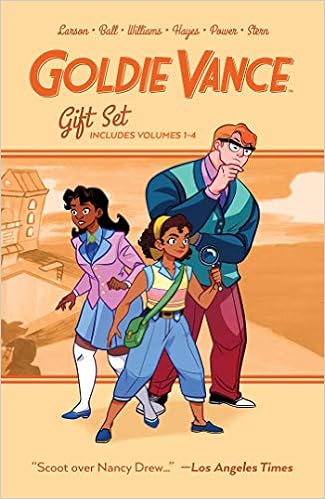
In theory, Marigold “Goldie” Vance works as a valet at the lush Crossed Palms resort in Florida where her dad is the manager. But she actually dreams of being a detective, and manages to embroil herself and her fellow hotel staff in a wide range of crime-solving activities. Goldie’s got a lot of spunk, and only hesitates briefly when she needs to, for instance, “borrow” a car to help her solve a case. While Larson’s cast is diverse, it doesn’t necessarily reflect the 1960s Florida it’s so clearly set in. An African-American acting as hotel manager? His biracial daughter from a mixed marriage? A potential queer relationship? Maybe it’s actually set in a parallel universe where bigotry was nowhere to be seen. Anyway, the mysteries are solid and take a range of twists and turns along the way. The collected volumes also have back matter that shows you how a few of the pages were developed by the creators.
The Pathfinders Society, Francesco Sedita
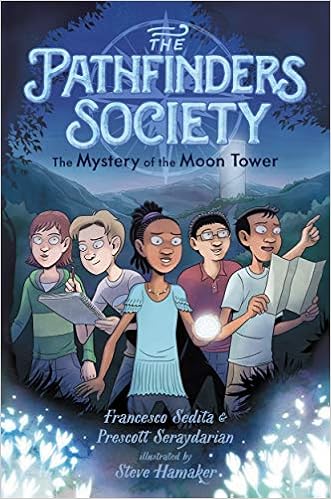
When the five protagonists of the book set out on a summer-camp-approved treasure hunt, they soon find themselves on the trail of a much older treasure that the town’s (and camp’s) founder sought and failed to find. And by soon, I mean, almost immediately. This book describes some clever puzzles that combine light magic and the puzzles of a modern-day puzzle hunt, but they’re hard to really appreciate as the book speeds you along through each one’s solution. The five kids are racially and socially diverse and each bring unique talents to the team, but you’ll barely get a chance to know each one.
Roller Girl, Victoria Jamieson

This Newbery medal winner is full of all the middle-grade feelings. Feeling like you don’t belong. Feeling big emotions. Feeling like your best friend is no longer your friend. Feeling nervous about middle school. Feeling the need to make an identity for yourself. And all set in a girl’s burgeoning love of roller derby. My daughter was 6.5 when she read this, and I imagine some of the tween angst went over her head, but she was bouncing and cheering during the final roller derby bout all the same. The protagonist and her closest friends are all Caucasian.
The Witch Boy series, Molly Knox Ostertag

In Aster’s magical community, boys learn shapeshifting and girls learn witchcraft. Period. But Aster is a boy who wants to learn witchcraft and doesn’t really want to gain his traditional shapeshifting role. As he struggles with his own desires and how they conflict with societal expectations, he meets a non-magic friend and ends up defeating a monster who has been corrupting the newly shapeshifting boys. While the story is enjoyable at the surface level, Aster’s journey is also a clear parallel to queer experiences (and there are two queer relationships – one obvious and one hinted at) that can give perspective and representation for readers. The series adds new characters as it goes but keeps its focus on finding your own way and the value of supportive communities.
Cleopatra in Space series, Mike Maihack

This sprawling sci-fi Egypt-themed adventure reminds me a lot of Buffy the Vampire Slayer for some reason. Cleopatra – the Cleopatra – is a super-strong fighter, but relies on a group of friends to actually beat the ubiquitous Big Bad. There’s a fair amount of middle grade/high school romantic feelings about, but overall this is a good romp with lots of action and political maneuvering.
Katie the Catsitter, Colleen AF Venable
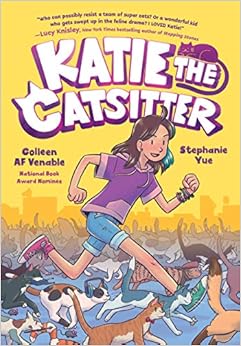
When Katie tries her hand at various summer jobs to save up money to go to camp, she eventually ends up catsitting for Ms. Lang, who lives upstairs in her building. But there’s not just one or two cats to mind. There are 217, and they’re … not exactly normal. One is an expert on computer hacking. Another specializes in robotics. And so on. Katie begins to suspect that her upstairs neighbor is actually the famous supervillain the Mousetress. And then begins to realize that perhaps she’s not the villain the media suggests. Along the way, Katie also has to navigate the most middle-grade of tropes: watching your friends change in ways you don’t understand and shaping your own new identity. Note that this book with a strong focus on animal rights mentions (but doesn’t show) dogfighting, poaching, and describes the horrible life of a NY Central Park carriage horse.
Pepper Page Saves the Universe!, Landry Q. Walker
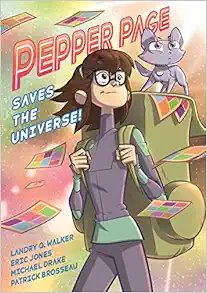
Shy, awkward Pepper Page is obsessed with comic-book-hero Supernova, even going so far as to buy print versions of the issues, a rarity in her society of flying school buses and holographic skins. This earns her predictable scorn from everyone in her life except her two good friends. But when she tries to save a cat from a mad scientist’s invention, she finds herself swept into the world of her comic book and discovers that she is, in fact, the real Supernova. (The cat, meanwhile, becomes her trainer as Master McKittens). The artwork here is both modern and a faithful reproduction of the comic-book style of the 60s and 70s, complete with the stippling and coloring you’d expect. Pepper’s long recitations of comic book facts poke gentle fun – the kind born from a deep love – at comic book culture.
Snapdragon, Kat Leyh

Snapdragon, the (biracial? Black?) protagonist of the story, recovers her dog from the old woman everyone believes is a witch. But it turns out the old woman has helped the pooch and merely has an odd business of restoring animal skeletons and selling them. Oh, and also, she actually is a witch. She begins to teach Snapdragon her crafts, and eventually reveals that she was in love with Snapdragon’s mother. There are plenty of queer themes here: Jacks, the old woman, is very butch. Lulu, who we first meet as Louis, is a transgender girl. And Snapdragon herself “isn’t into the things girls are into.” Strong character arcs and back story make this a rich narrative.
Diesel: Ignition Tyson Hesse

It’s hard to sympathize with Dee Diesel, the Caucasian protagonist of this sci-fi adventure set in a post-apocalyptic, post-war world. The book starts with her lording her imminent ownership of floating city Peacetowne over everyone she can. Her refusal to listen and consider others leads directly to the city being shot down, resulting in the deaths of half the population. But in the end, she puts herself at risk in order to help a city full of people under attack by their old enemies. Enemies who used to be flying bird people but lost the ability to fly when Dee’s adoptive father bioengineered a mutation that grounded them. Dee and one of her other adopted siblings have an ability to generate sparks of power with a snap of their fingers, but we never find out why that’s the case. This was clearly intended to be a setup for a larger story, but as far as I know the rest of the story wasn’t developed.
Princeless series, Jeremy Whitley

If Lumberjanes isn’t feminist enough for you, be sure to check out this series in which princess Adrienne (who is Black) effects her own rescue from the tower her sexist, misogynist father put her into. After convincing her guardian dragon to side with her and befriending a woman dwarf blacksmith, the princess sets off to rescue her sisters and others she finds locked up. Her brother, meanwhile, is a disappointment to their father because he wants to go into theater. The first book features an amusing look at “traditional” armor for women that might require an explanation if your child hasn’t seen the typical ludicrous bikini armor of male-gaze artwork.
Trespassers, Breena Bard
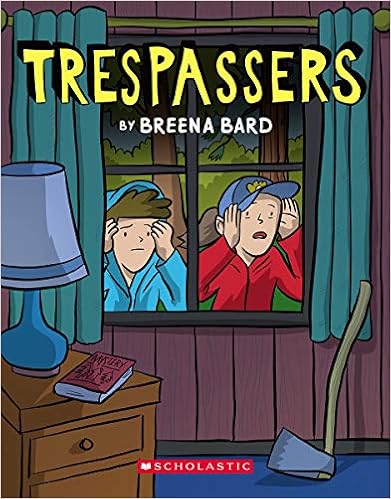
Gabby’s family’s annual stay in Wisconsin’s North Woods goes a different route this year when she wonders about the large, empty house nearby. Prompted by her mom, she decides to write a mystery story about the house, and her imagination quickly takes over, especially as new North Woods visitor Paige makes the fictional story seem more and more plausible. By the time Gabby learns the truth, she is sure that the cabin’s kind neighbor in fact committed a double murder years ago. He didn’t. There’s a lot going on in the background of this story. Paige rebels against her parents because she loathes the fact that they’re defense attorneys who defend criminals. Gabby’s oldest sister is applying to college, and a tense backdrop develops as Gabby’s dad is made redundant at his current job. Meanwhile, the family enjoys the cabin, kayaks, and swims like any other normal camping family.
The Secret Garden on 81st Street, Ivy Noelle Weir

I’ve never read Francis Hodgson Burnett’s classic The Secret Garden, but from what I can tell from the Wikipedia summary, this graphic novel adaptation stays true to the plot, characters, and core messages while setting it in a more modern milieu with a racially diverse cast. Mary Lennox is an isolated kid whose parents work too much at their tech jobs and is often on her own. Her social activity is online gaming, and she gets food by calling Uber Eats. When her parents die, she’s sent to live with her uncle, who lost his husband a few years back. Along the way, she meets her cousin Colin, here prone to panic attacks after his dad’s death. The dead dad’s garden has been left to die because it’s too painful, but Mary and her new friend Dickon, and eventually Colin, work together to restore the garden and heal the sorrow in the house.
Mouse Guard series, David Petersen
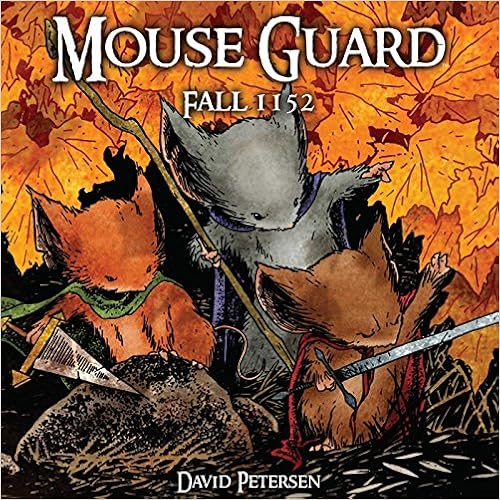
This complex adventure features mice in a medieval-style world warding off predators but also political unrest within the mouse kingdoms. The titular Guard are fierce, loyal soldiers. The artwork in this is rich, though it can be hard to see what’s going on in the many fight scenes as the camera twists and turns.
Rickety Stitch & The Gelatinous Goo series, James Parks

While animated skeletons are common enough in Rickety Stitch’s land, he seems to be the only one who talks and sings. The series follows him and his best friend, The Gelatinous Goo (a blob-shaped creature that only Rickety can understand) as they seek to find out why Rickety is different. Black-and-white dream sequences give the readers the ability to infer some details, but they’re still confusing and opaque. I like that this series imagines a world after big wars between good and evil and the life the normal denizens lead in the uncivilized world. And props to the production team for actually creating recordings of some of the original songs featured in the book.
Estranged, Ethan Aldridge
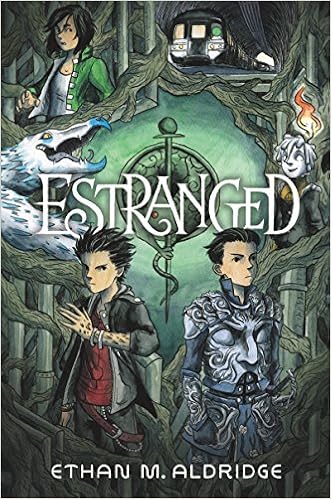
Fairies swapping fairy babies for humans is a common staple of European mythology, but what happens to those kids when they grow up? Estranged picks up a dozen years or so after the switch, where Edmund, a fairy in our world, struggles to keep his fairy nature hidden and his human counterpart is simply known as The Childe and is treated like a trophy at a fairy court. But when the fairy king and queen are turned into rats by the queen’s sister Hawthorne, The Childe travels with his page Whick (a nonbinary wax golem with a candle wick set in their head) to find Edmund, the true prince, to defeat Hawthorne. Along the way, the two boys struggle with what family matters and what matters about family. This is a strong epic fantasy story with a large hidden world tucked under the city streets.
The Dragon Path, Ethan Young

As the Wong clan makes their way to the Old Land, the historical home they had to abandon when a monster drove them out 100 years ago, they are attacked and captured by their old foes the Dragon Tribe. Prince Sing, heir to the Wong clan’s leader, escapes and finds out that the stories about the Old Land are not exactly correct. He, the “monster,” and the mystic have to rescue their family and return Old Land to them. There’s a lot of action and twists and turns in this book, and the end result is different than you might imagine.
Avatar: The Last Airbender series, various authors

If you, like us, enjoyed the Avatar: The Last Airbender TV series, it’s worth knowing that there are a number of graphic novels that expand the series. The comic books, written in consultation with the show creators, largely pick up where the show left off, and add complex themes such as how to separate towns that have come to a peaceful coexistence during the Fire Lord war, bender vs. nonbenders, and more. Some standalone books feature fan favorites Katara, Toph, and Suki in independent stories.
5 Worlds series, Mark Siegel, Alexis Siegel, lots of other people

This is a rich sci-fi/fantasy epic adventure that has themes of oppression, climate change, and more. We ate these books up and are eagerly awaiting the next one. The three main protagonists (drawn in different races) include Oona, a sand dancer who can manipulate the magical sand scattered around the 5 Worlds; An Tzu, a boy from the slums of the main world who is slowly dying from a “fading sickness” that causes him to be more invisible over time; and Jax Amboy, a starball player who An Tzu worships. The three have to work together to light the “5 beacons” established by the old gods. There are surprises aplenty in these books.
Science Comics series, various authors

Each volume in this series is packed with lots of good information. Most have a light narrative framework (with Volcanoes being the most extreme), but they’re really about showing off lots of great facts about their topic with great illustrations.
All’s Faire in Middle School, Victoria Jamieson

Parents note: This is definitely better for older kids; there’s some borderline explicit content. Aside from that, this is a typically warm and sympathetic Jamieson book focused on Imogene, who was homeschooled until middle grade and whose parents work at the local Renaissance Faire. She tries to navigate middle school’s many challenges, framing them in the context of a Middle Age story of knights and dragons and getting advice from her “Faire-mily.” The middle grade tropes are in full force: befriending the popular girl and learning she’s actually horrible, odd thoughts about boys, insecurity about her clothes and house, and finding a true friend after doing something mean to her as prompted by the queen bee mean girl. Meanwhile, you’ll get some behind-the-scenes views of Ren Faires and how they work.
Star Wars: Princess Leia, Mark Waid

Similar to the Darth Vader comic (see below), this 5-issue arc (collected into an omnibus volume) focuses on Princess Leia’s activities immediately after A New Hope – the book starts with the award ceremony. Here we see Leia trying to gather up and find a home for the Alderaanians who were not on the planet when it exploded. While not as epic as the Darth Vader series, it does give some insight into what’s going on in Leia’s head as she processes Alderaan’s destruction and sets the stage for her transition from Princess to General.
Star Wars: Darth Vader, Kieron Gillen

At the end of A New Hope, Darth Vader, working under Grand Moff Tarkin, has made a mistake that cost the Empire its Death Star. But by the beginning of The Empire Strikes Back, he’s in command of a fleet, reporting directly to the Emperor, and has learned that the Emperor lied to him; he has a son. What happened in the few years between the two stories? That’s the tale that Gillen chooses to tell in this very well regarded, multivolume comic book. Vader has to deal with the Emperor’s machinations, Imperial politics, and his own investigations into the mysterious pilot who blew up the Death Star. While there are humerous parts, this is definitely a book for older readers – one of the story’s droids is a callous killing machine and the other revels in torture, though it usually happens off-screen. Our library keeps it in the teen section.
Star Wars: Doctor Aphra, Kieron Gillen

When you finish the Darth Vader series above, find out what happens to that comic’s Indiana-Jones-meets-a-more-mercenary-Han-Solo archaeologist as she keeps a low profile and seeks to repay various debts she’s accrued in her questionable past. Aphra became a fan favorite during Darth Vader, and this series continues through seven omnibus editions.
The Daughters of Ys, M.T. Anderson
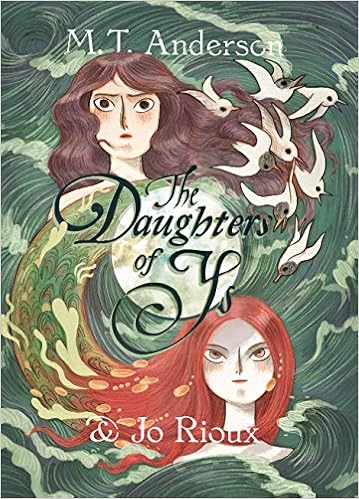
Note that this contains images of, uh, people kissing while naked in bed. It’s also a pretty dark tale, a retelling of an old Breton myth in which one of two sisters sacrifices men to the dark spirits who keep the city of Ys safe from the encroaching sea. The older sister would prefer to spend her time in nature, but ultimately is betrayed by her younger sibling and hardens her heart. In the end, the sacrificial payment isn’t made and the city of Ys is destroyed by the ocean. So save this for when your kids are old enough!
Earth Before Us series, Abby Howard
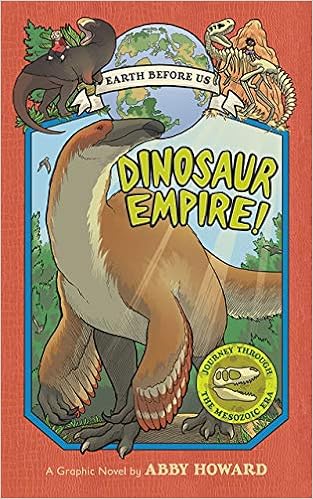
A must-read for any fan of prehistory, this series spans the earliest animals, the dinosaurs, and the large mammals of relatively recent geologic time. Detailed drawings and pronunciation guides will draw in readers of all ages, and even grownups will probably learn some things. The story, such as it is, involves a young girl of color finding out that her next-door neighbor is a Caucasian paleontologist who travels through time via portals in her (and other) recycling bins. But largely the story takes a back seat to the extensive catalog of which animals are alive when.
Maker Comics series, various authors

This companion series to Science Comics is off to a great start with Bake Like a Pro. The series will teach kids DIY activities within the context of a straightforward story.